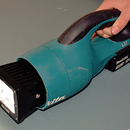Introduction: Digital Manufacturing - Desk Name Plate Project
Digital manufacturing doesn't have to be expensive or difficult, with an old computer, free software and a hiring a machine for a few minutes you can make things that would not be possible in a home workshop!
If you haven't seen project one, take a look as it covers where to get the Prodesktop, how to activate the software, how to navigate the screen, what you will need and the mouse functions.
Digital Manufacturing - project one Key tag
Digital Manufacturing - project three 3D printed box
Digital Manufacturing - project four laser cut box
Digital Manufacturing - project five printed toy car
As computer tutorials don't translate to text very well, for this series of instructables most of the info is in the photos. So click on the first photo and use the arrows to go to the next photo. The boxes in the photos show the location of the icons and have have text in them when you hover the mouse on them.
Step 1: Learning Intentions and Success Criteria
Learning Intentions
- To work safely in the workshop
- To improve my understanding of how the CAD software works
- To operate a laser cutter
Success Criteria
- I understand the safety rules and I am working safely in the workshop.
- I can produce 2D and 3D CAD drawings and convert them to a DXF file.
- I can produce an assembly drawing.
- I can produce a photo album drawing of my project.
- I can operate a laser cutter safely and work safely in the workshop.
Step 2: Designing Your Project and Fixing Common Mistakes
- First the thickness of the material that is available will affect parts of your project. For this project I'm going to use 3mm acrylic. You can use what every size you have as long as your laser cutter can cut it, and you make the tabs and holes the right size.
- The size of the laser cutter is also very important, will your project fit inside the laser cutter and will it cut the thickness of the materiel you have.
Ok lets get started, click on the first photo and use the arrows to follow along
Step 3: Assembling the Project and Checking for Mistakes
This step will show you how to make your project 3D and assemble the parts, so that you can check for problems and look at the aesthetics of your project.
As always chick on the photo and follow along
Step 4: Engineering Drawing
Engineering Drawings are great to have, you can show others your design and if you have to get someone else to build your project then it makes it easy for everyone.
This step will show you how to put measurements an notes on your engineering drawing.
Click on the photos to follow along.
Step 5: Photo Album
In this step we will make a nice rendered drawing that looks like a photo. You can export this image as a JPG and print it eamil it or put on a web site.
This is really good for showing off your work or showing a client to get work.
Step 6: Exporting a DXF Ready for the Laser Cutter
The last step, we need to create a DXF file so that we can send our project to a CNC machine. A DXF file is a 2D format that is used by most good CAD programs so you can email this file to an engineering shop anywhere and they will be able to use it.
First thing go back to your 2D drawing.
Ok lets get to it!
There is some more info about setting up the laser in the first project
Attachments

Participated in the
UP! Contest














